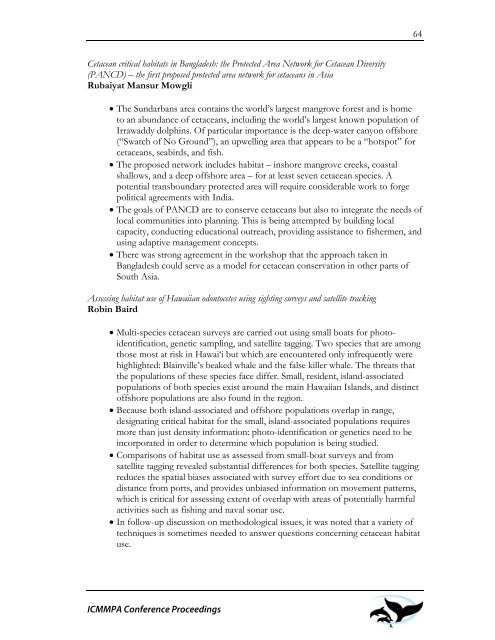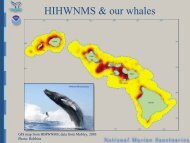The First International Conference on Marine Mammal Protected Areas
The First International Conference on Marine Mammal Protected Areas
The First International Conference on Marine Mammal Protected Areas
Create successful ePaper yourself
Turn your PDF publications into a flip-book with our unique Google optimized e-Paper software.
Cetacean critical habitats in Bangladesh: the <strong>Protected</strong> Area Network for Cetacean Diversity<br />
(PANCD) – the first proposed protected area network for cetaceans in Asia<br />
Rubaiyat Mansur Mowgli<br />
• <str<strong>on</strong>g>The</str<strong>on</strong>g> Sundarbans area c<strong>on</strong>tains the world’s largest mangrove forest and is home<br />
to an abundance of cetaceans, including the world’s largest known populati<strong>on</strong> of<br />
Irrawaddy dolphins. Of particular importance is the deep-water cany<strong>on</strong> offshore<br />
(“Swatch of No Ground”), an upwelling area that appears to be a “hotspot” for<br />
cetaceans, seabirds, and fish.<br />
• <str<strong>on</strong>g>The</str<strong>on</strong>g> proposed network includes habitat – inshore mangrove creeks, coastal<br />
shallows, and a deep offshore area – for at least seven cetacean species. A<br />
potential transboundary protected area will require c<strong>on</strong>siderable work to forge<br />
political agreements with India.<br />
• <str<strong>on</strong>g>The</str<strong>on</strong>g> goals of PANCD are to c<strong>on</strong>serve cetaceans but also to integrate the needs of<br />
local communities into planning. This is being attempted by building local<br />
capacity, c<strong>on</strong>ducting educati<strong>on</strong>al outreach, providing assistance to fishermen, and<br />
using adaptive management c<strong>on</strong>cepts.<br />
• <str<strong>on</strong>g>The</str<strong>on</strong>g>re was str<strong>on</strong>g agreement in the workshop that the approach taken in<br />
Bangladesh could serve as a model for cetacean c<strong>on</strong>servati<strong>on</strong> in other parts of<br />
South Asia.<br />
Assessing habitat use of Hawaiian od<strong>on</strong>tocetes using sighting surveys and satellite tracking<br />
Robin Baird<br />
• Multi-species cetacean surveys are carried out using small boats for photoidentificati<strong>on</strong>,<br />
genetic sampling, and satellite tagging. Two species that are am<strong>on</strong>g<br />
those most at risk in Hawai‘i but which are encountered <strong>on</strong>ly infrequently were<br />
highlighted: Blainville’s beaked whale and the false killer whale. <str<strong>on</strong>g>The</str<strong>on</strong>g> threats that<br />
the populati<strong>on</strong>s of these species face differ. Small, resident, island-associated<br />
populati<strong>on</strong>s of both species exist around the main Hawaiian Islands, and distinct<br />
offshore populati<strong>on</strong>s are also found in the regi<strong>on</strong>.<br />
• Because both island-associated and offshore populati<strong>on</strong>s overlap in range,<br />
designating critical habitat for the small, island-associated populati<strong>on</strong>s requires<br />
more than just density informati<strong>on</strong>: photo-identificati<strong>on</strong> or genetics need to be<br />
incorporated in order to determine which populati<strong>on</strong> is being studied.<br />
• Comparis<strong>on</strong>s of habitat use as assessed from small-boat surveys and from<br />
satellite tagging revealed substantial differences for both species. Satellite tagging<br />
reduces the spatial biases associated with survey effort due to sea c<strong>on</strong>diti<strong>on</strong>s or<br />
distance from ports, and provides unbiased informati<strong>on</strong> <strong>on</strong> movement patterns,<br />
which is critical for assessing extent of overlap with areas of potentially harmful<br />
activities such as fishing and naval s<strong>on</strong>ar use.<br />
• In follow-up discussi<strong>on</strong> <strong>on</strong> methodological issues, it was noted that a variety of<br />
techniques is sometimes needed to answer questi<strong>on</strong>s c<strong>on</strong>cerning cetacean habitat<br />
use.<br />
ICMMPA <str<strong>on</strong>g>C<strong>on</strong>ference</str<strong>on</strong>g> Proceedings<br />
64



